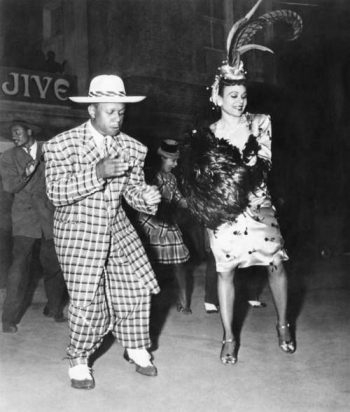“I want a zoot suit with a reet pleat
And a drape shape, and a stuff cuff
To look sharp enough to see my Sunday gal.”
A ZOOT SUIT (FOR MY SUNDAY GAL) – Click to Listen
(L. Wolfe Gilbert / Bob O’Brien)
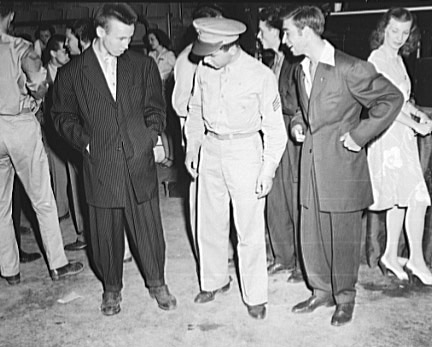
1940s Zoot Suit History
The zoot suit was a style of dress that became popular during the late 1930s among young people, especially young African Americans and Mexican Americans, who were into swing dancing and jazz music.
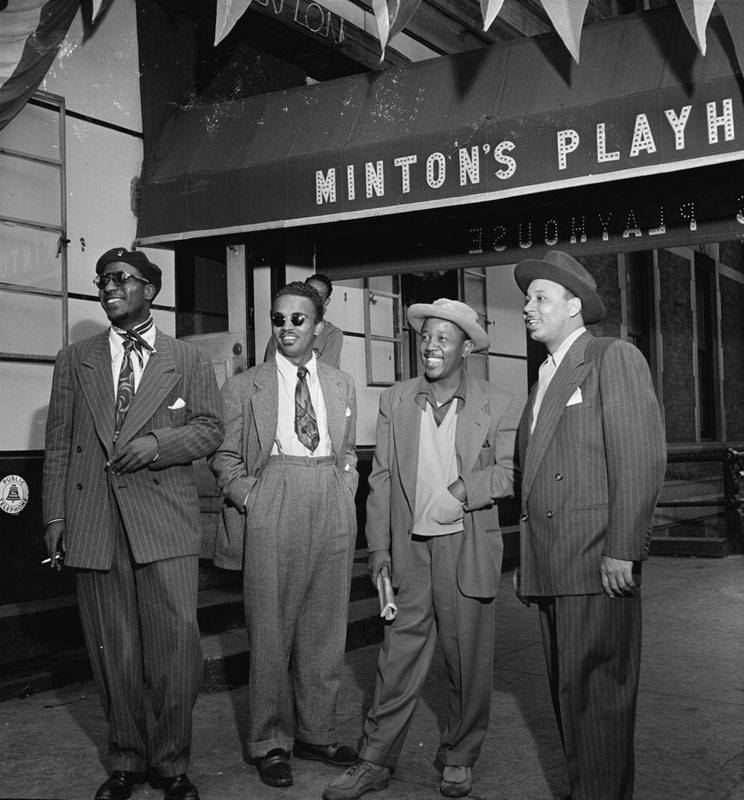
Men in Zoot Suit fashion
The zoot suit of the 1940s was full of scandal. Technically illegal due to the abundance of fabric needed to make it and the restrictions placed by the war board, it was the underground dress uniform of young, urban, rebellious men. These “swing kids” danced in jazz clubs, purchased their clothes on the black market, and in L.A. caused a month long street war.
Young people continued to wear the style, and the suits soon became associated with delinquency and crime. Most wearers were simply rebellious youths, many in inner city areas like Harlem and Los Angeles, trying to form a culture all their own. The wearers of zoot suits were seen as being unpatriotic, and tensions between zoot-suiters and military servicemen stationed in California erupted in a week of violent street fighting in Los Angeles in mid-1943 that came to be known as the Zoot Suit Riots.
Zoot Suit Style
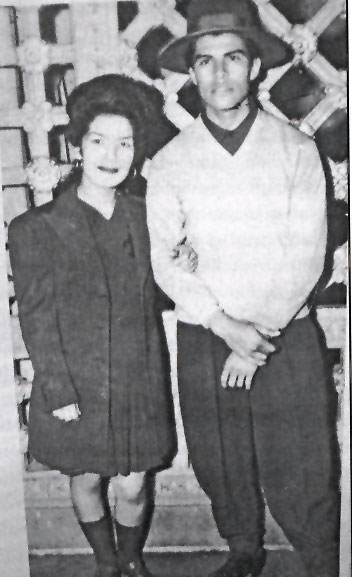
Man and Woman in Zoot Suit Fashion
The man’s zoot suit consisted of an extremely long and wide two-button suit jacket with large notch lapels and huge shoulder pads, worn over extremely baggy trousers that came well above the waist – about halfway up the chest. The pants tapered at the bottom to a very tight cuff at the ankles and were held up with suspenders.
A plaid button-down shirt, tie, shiny leather shoes, and a wide-brimmed fedora hat completed the look on the east coast.
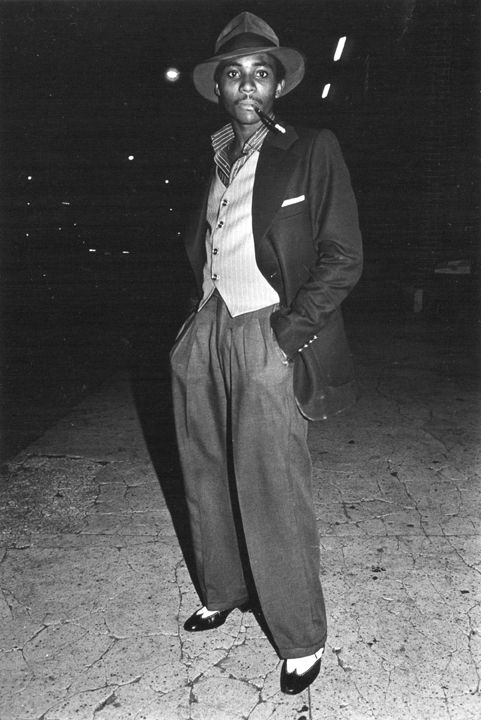
East Coast zoot suit outfit
On the west, the tie and hat were replaced by hair greased back into a tail. The zoot suit was usually wool and in black pinstripes, plaids or very bright colors like red, royal blue, yellow and purple. Some zoot suit styles featured a dark suit jacket worn over light zoot “chino” pants. The homemade jackets had very large patch pockets on either side. Extra-wide and short ties, a matching pocket square, and big fluffy bow ties were most popular with performing musicians.
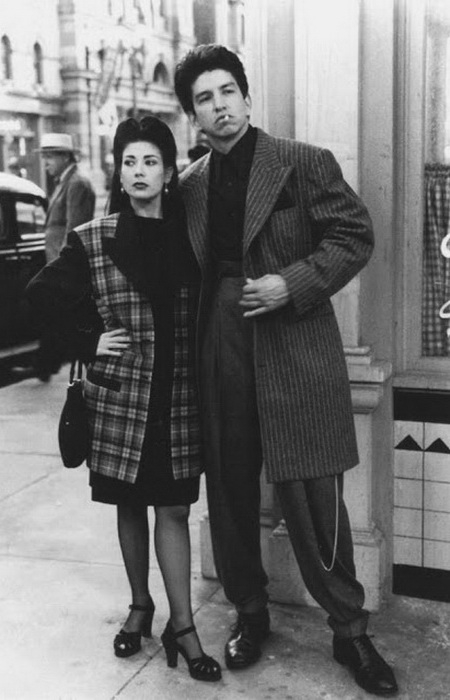
L.A. Zoot Suit
Fardi Chenounce in A History of Men’s Fashion describes the zoot suit perfectly:
“The original American outfit was the zoot suit, with its oversized jacket (often double breasted, always wide shoulders) that might be striped or checked, fell to the knees and hung like some baggy frock coat. Low-crotched zoot pants that were held up by eccentric suspenders, swallowed the lower half of the bust, then skirted around the hips and bagged at the thighs before narrowing to sit softly on fine, lightweight shoes. This euphoric costume would be completed- or rather, rendered more glorious by striking, luxuriantly hand painted tie, a colorful pocket-handkerchief, an endless watch chain, and a wide-brimmed hat.”
Plaid Zoot Suit
When Malcolm X went to buy his first Zoot suit, he recalled the salesman “picked off the rack a zoot suit that was just wild: sky-blue pants thirty inches in the knee and angle-narrowed down to twelve inches at the bottom, and a long coat that pinches my waist and flared out below my knees.” Malcolm also bought a blue hat with a four inch brim and feather, leather belt, and long gold-plated chain.
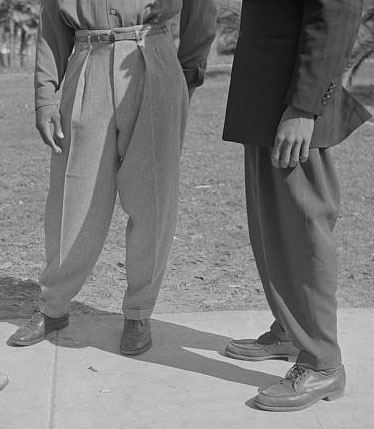
Zoot Suit Pants
Around the world other rebellious youths adopted the zoot suit look. In France the Zazous wore oversized suits with short trousers, exposing bright white socks and platform shoes. A wild print tie, thin mustache, quaffed hair and a rolled umbrella finished the look. See a vintage zoot suit here.
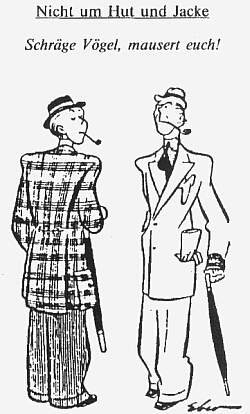
German “Swing Kids” Fashion
In Germany, the “Swing Kids” danced in underground parties to the new American “jazz” music. They wore double breasted pinstripe suits with high, pinched-in waists, extra-large lapels, and carried a rolled umbrella. To archive the oversized suit look, many economical young men purchased suits in a few sizes up and modified them to form the tight waist and shorter trousers.
It is interesting to note that despite the Zoot style being considered unpatriotic during the war, afterwards the style became the new men’s look of the late ’40s and early ’50s. Large double breasted baggy suits with high waists, pleated trousers and wide brim hats returned to fashion just as they were in the 1930s, but now with a taste of the zoot in them.
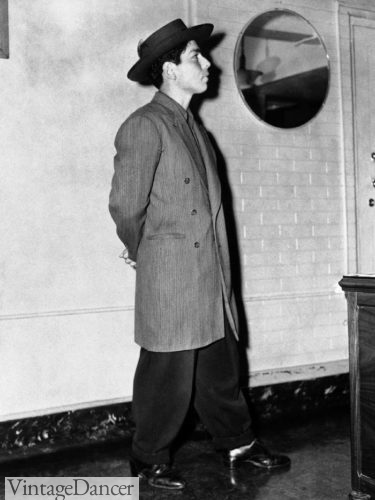
1943 young Zoot Suit wearing youth with pork pie hat, long coat, and peg pants
Buying Modern Zoot Suits
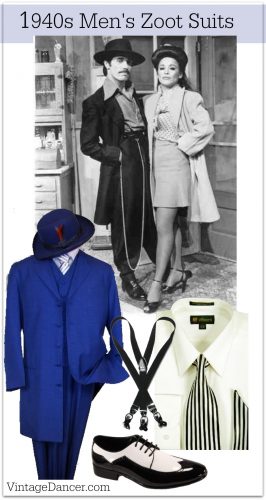
Zoot Suit Fashion
Today, the 1940s zoot suit is immortalized as the greatest 1940s fashion for men, especially with dancers. It is also the inspiration for African-American men’s fancy dress (for church and formal events). These modern zoot suits are really great alternatives to vintage or reproduction zoot suits for their outlandish style, bold colors, and affordability — not to mention, they are still modern enough to wear to any stylish party today (you will get a lot of attention wearing these suits). They seem to be especially popular for 1940s themed weddings and vintage swing dance parties.
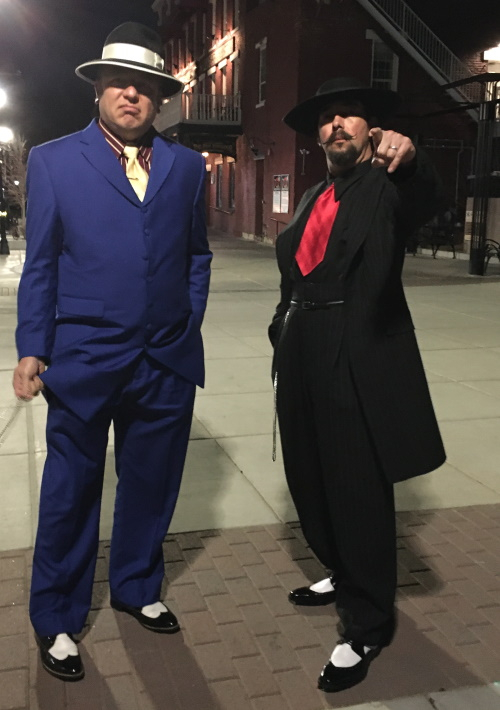
Two Zoot Suit outfits
- Stacy Adams is a modern brand that you might be able to find locally or online. Their signature style has embraced 1940s fashion since the 1990s revival. You can still find vintage inspired hats, shoes and some suits both on their website and at other retailers that carry the Stacy Adams line. Other options for Zoot Suits are:
- MensUSA has a variety of brands that feature the wide leg, baggy look of a Zoot Suit
- www.suavecito.com features off the rack or custom made men’s zoot suits to tent or buy
- www.elpachuco.com sells reproduction zoot suits, shirts, shoes, hats, and accessories
- For more research, read Zoot Suit: An Enigmatic Career of an Extreme Style by Kathy Peiss
Debbie Sessions has been teaching fashion history and helping people dress for vintage themed events since 2009. She has turned a hobby into VintageDancer.com with hundreds of well researched articles and hand picked links to vintage inspired clothing online. She aims to make dressing accurately (or not) an affordable option for all. Oh, and she dances too.
